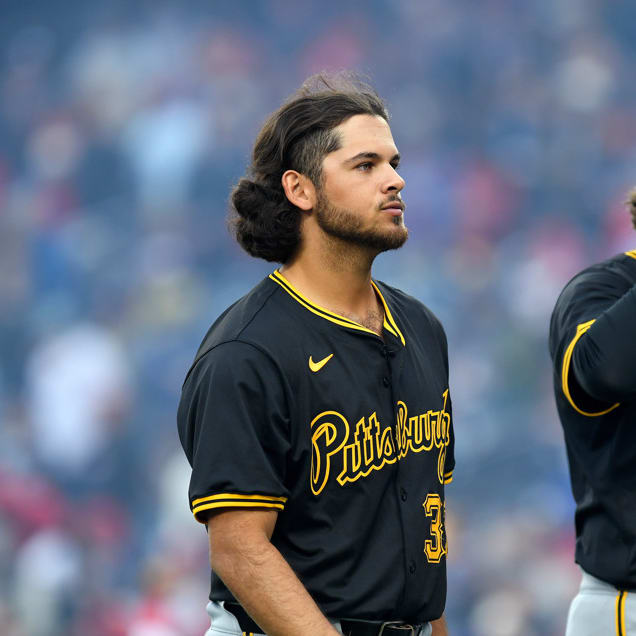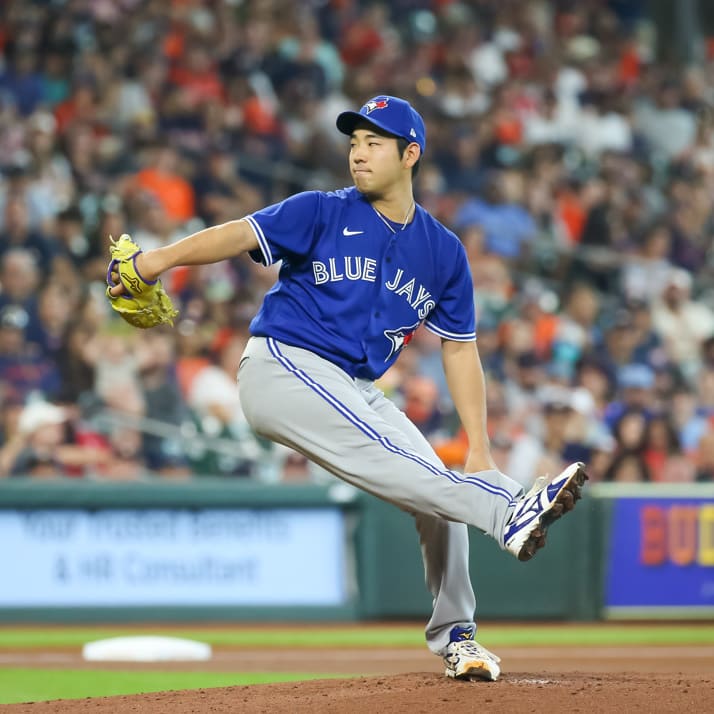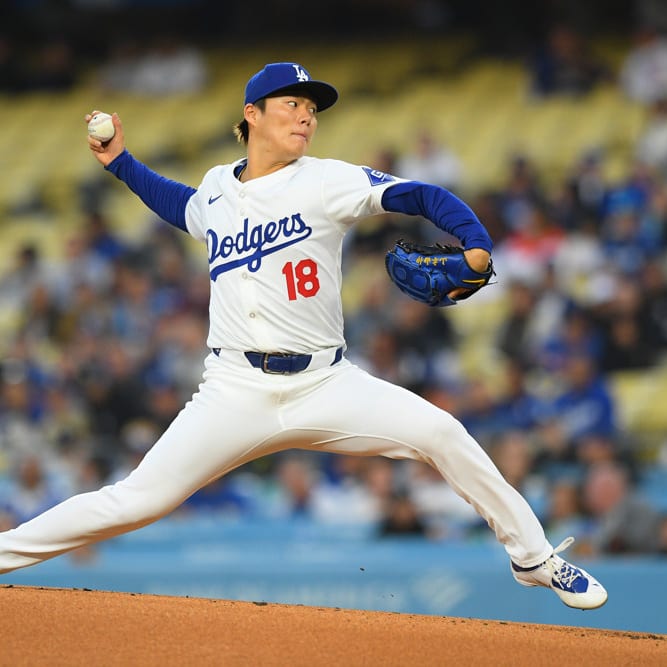This article is part of our Farm Futures series.
With the minor league season coming to a close, it's time to hand out some hardware to the pitching prospects who stood out the most in full-season leagues (the hitting awards were handed out last week). Players who have made it to the big leagues were not considered for the awards, even if they qualified. A player winning the "Most Impressive" award doesn't necessarily mean that they are the most valuable dynasty league prospect at that specific level, it simply means that prospect had the most impressive season. The same logic applies for the "Most Improved" and "Biggest Disappointment" awards.
Triple-A
Most Impressive: Josh Hader (Brewers)
I've written a lot about Hader over the past 12 months, to the point that there is really not much new to say until we see how he does against big league hitters. The fact is, he is the most intriguing pitching prospect who finished the year at Triple-A while not receiving a September call-up. It's obvious why the Brewers would not want get his service time clock started, especially since they are not hurting for big league-ready starting pitchers on the 40-man roster. Still, it's a bit of a shame we didn't get to see Hader face big league hitters over the final month. His overall numbers at Triple-A look pretty bad (5.22 ERA, 1.43 WHIP), but he posted a 4.50 ERA, 1.34 WHIP and 54 strikeouts in 38 innings away from Colorado Springs, which is pretty solid for a 22-year-old getting
With the minor league season coming to a close, it's time to hand out some hardware to the pitching prospects who stood out the most in full-season leagues (the hitting awards were handed out last week). Players who have made it to the big leagues were not considered for the awards, even if they qualified. A player winning the "Most Impressive" award doesn't necessarily mean that they are the most valuable dynasty league prospect at that specific level, it simply means that prospect had the most impressive season. The same logic applies for the "Most Improved" and "Biggest Disappointment" awards.
Triple-A
Most Impressive: Josh Hader (Brewers)
I've written a lot about Hader over the past 12 months, to the point that there is really not much new to say until we see how he does against big league hitters. The fact is, he is the most intriguing pitching prospect who finished the year at Triple-A while not receiving a September call-up. It's obvious why the Brewers would not want get his service time clock started, especially since they are not hurting for big league-ready starting pitchers on the 40-man roster. Still, it's a bit of a shame we didn't get to see Hader face big league hitters over the final month. His overall numbers at Triple-A look pretty bad (5.22 ERA, 1.43 WHIP), but he posted a 4.50 ERA, 1.34 WHIP and 54 strikeouts in 38 innings away from Colorado Springs, which is pretty solid for a 22-year-old getting his first taste of the Pacific Coast League. He probably won't break camp in the big league rotation, as the Brewers will want to gain an extra year of control, but he should be the first arm summoned from the minors in 2017 when a rotation spot opens up.
Most Improved: Jharel Cotton (A's)
This may be cheating a little, but this article should get posted before Cotton makes his MLB debut Wednesday. He pitched well in 2015 but I thought he would be a reliever all the way until this season, which is why he wins "Most Improved." Cotton showed the ability to go deeper into games, pitching at least five innings in his last 18 starts and logging seven-plus innings in three of his last eight, while navigating the harsh pitching conditions of the Pacific Coast League. He impressively fanned 155 batters while walking just 39 in 135.2 innings between the Dodgers and Athletics affiliates in the PCL, as his 5-foot-11 frame raises concerns about his ability to miss barrels against advanced hitters. I would expect him to have at least a handful of really rough outings initially in the big leagues as he adjusts to hitters with a keener eye and umpires who will be less likely to give him borderline calls on the edges of the zone. However, there should also be a couple of outings early on that give prospective owners something to dream on. There is a chance he could emerge as a mid-rotation arm in time for Oakland and he could end up being the best of the three pitchers they received from the Dodgers at the deadline. The A's have a slew of back-end starter types who are essentially big league ready, but I expect Cotton to get a fairly long leash in the rotation as his ceiling is much higher than that of most of his organizational mates and the A's don't need consistent production right away.
Biggest Disappointment: Jorge Lopez (Brewers)
This is an easy call. I had plenty of hits this year (and some misses) but nobody made me look worse than Lopez, who I thought would be a mixed league option for a good chunk of the season. Instead he completely failed in his first taste of Triple-A, posting a 6.81 ERA and 66:55 K:BB in 79.1 innings with Colorado Springs before being mercifully demoted to Double-A in late July. Lopez can't even blame his struggles on the impossible pitching conditions at Colorado Springs, as his road ERA was actually worse than his home ERA prior to his demotion. He had quality starts in three of his last four outings with Double-A Biloxi to finish the season on a positive note, but Lopez no longer looks like a cinch to be a part of the next great Brewers rotation. As a member of the 40-man roster he will have a chance to pitch his way to the majors next season, but first he will presumably be tasked with a return trip to the PCL, which could spell disaster once again if he hasn't made significant adjustments.
Double-A
Most Impressive: Francis Martes (Astros)
Martes, 20, burst onto the scene as a high-upside but relatively untested pitching prospect last year. He followed that up by truly establishing himself as one of the top pitching prospects in the game, posting a 3.30 ERA, 1.20 WHIP and 131:47 K:BB in 125.1 innings as the youngest starting pitcher in the Texas League. He has two potentially double-plus pitches in his fastball and curveball and is showing surprisingly excellent command for someone his age with this kind of electric arsenal. That campaign will have him on the radar of single-season owners heading into 2017 and it leaves him knocking on the door of the top 25 in offseason top 200 rankings for dynasty leagues. He safely profiles as having a mid-rotation floor with top-of-the-rotation upside if his changeup takes a step forward and his command ticks up slightly. Stephen Gonsalves, David Paulino, Tyler Beede and German Marquez also deserve mentions in this category.
Most Improved: Brandon Woodruff (Brewers)
Woodruff actually has a case to be the "Most Impressive" and the "Most Improved" as he has been completely dominant this year in the Southern League, doing so with legitimate stuff despite the fact he lacks pedigree and at 23 is older than most of the noteworthy prospects at Double-A. He struck out 173 while walking just 40 batters over 158 innings across High-A and Double-A this year (113.2 of those innings coming with Double-A Biloxi) and limited minor leaguers to a .209 batting average against. A plus fastball, excellent command and an impressive 6-foot-4, 215 pound frame suggest Woodruff has a comfortable floor as a No. 3 or No. 4 starter, and he should get the chance to prove himself capable of turning over big league lineups at some point next summer. Dinelson Lamet and Chih-Wei Hu also deserve recognition here.
Biggest Disappointment: Rob Kaminsky (Indians)
If a pitcher goes from striking out 20.1 percent of hitters at High-A to striking out 16.1 percent of hitters at Double-A, that's typically not a good sign. That's exactly what Kaminsky did this year, lowering his realistic ceiling from mid-rotation starter to a back-of-the-rotation southpaw. His 3.28 ERA is fine and good but a 92:48 K:BB in 137 innings just won't get owners excited in dynasty leagues of any size, especially when the quality of his stuff was already a concern heading into the season. He is no longer a top 200 prospect overall or a top 10 prospect in Cleveland's farm system.
High-A
Most Impressive: Erick Fedde (Nationals)
While Fedde has been 23 years old all season he's younger than that in pitcher years, as he was entering just his second season as a healthy professional. After a slow start, he proved in June and July to be far superior to the hitters he was facing in the Carolina League, leading to a promotion to Double-A in August. At High-A, Fedde posted a 2.85 ERA, 1.13 WHIP and 95:19 K:BB in 91.2 innings despite posting a 4.91 ERA in April and a 5.09 ERA in May. Indeed, he allowed just two earned runs over six starts in July, re-establishing himself as a surefire top 100 prospect in the process.
Most Improved: Luis Castillo (Marlins)
Probably best known for being traded to the Padres and then sheepishly traded back to the Marlins when Colin Rea's elbow gave out after the trade, Castillo has emerged as one of the best prospects in a desolate Marlins system. He sports a 80-grade fastball with a quality slider and a changeup that is a bit of a work in progress, but there is still plenty of time for refinement in the upper levels of the minors. That incomplete repertoire was still more than enough to dominate Florida State League hitters as he posted a 2.07 ERA, 0.96 WHIP and 91:18 K:BB in 117.2 innings with High-A Jupiter. The lack of strikeouts despite cheddar that touches triple digits illustrates his lack of a consistent out pitch among his secondaries, so he will need to continue to improve those offerings if he hopes to have success as a starter at Double-A and Triple-A. That said he is relatively new to starting, having worked exclusively as a reliever from 2012 to 2014, so becoming more adept at sequencing will also help increase his K-rate. This is an arm that could take a big jump up prospect lists next season. Trevor Clifton, Fernando Romero and Yency Almonte also deserve mentions here.
Biggest Disappointment: Grant Holmes (A's)
Even prior to coming over to the A's as the headliner in the Josh Reddick/Rich Hill trade, Holmes had struggled to command the ball the way a future No. 2 or No. 3 starter needs to, posting a career-worst 1.39 WHIP in 105.1 innings with High-A Rancho Cucamonga. Part of that is the California League favoring offense but for a pitcher with Holmes' raw stuff and upside, it wasn't unreasonable to look for him to mow down High-A hitters all summer long. He failed to increase his stock prior to the trade and, since entering Oakland's system, his outlook has taken a noticeable hit after allowing 22 earned runs while posting a 24:10 K:BB in 28.2 innings with High-A Stockton. While some of that could be attributed to the harsh pitching conditions and potential mechanical adjustments suggested by his new team, it also has a whiff of the Dodgers cutting bait at the exact right time on an arm they perceived to be overvalued by the industry. Keury Mella is also worth mentioning here, as he appears to have sacrificed strikeouts in favor of command and his opportunistic dynasty league owners no doubt hoped he could find a way to have one without giving up the other.
Low-A
Most Impressive: Mitch Keller (Pirates)
I've written about Keller here recently and no pitcher was more fantastic over as many innings at Low-A as Keller was this year. He shouldn't be viewed as a future top-of-the-rotation type, but he's as much of a lock to settle in as a No. 3 starter as any pitcher who has yet to reach Double-A can be. Mike Soroka and Marcos Diplan deserve some praise in this category and while Triston McKenzie doesn't have enough innings at the level to earn the nod, he still deserves a shout out for how dominant he has been in a second half run in the Midwest League.
Most Improved: Touki Toussaint (Braves)
Make no mistake, Toussaint is still among the riskier prospects pitching in full season leagues, but he has made great strides from last year. After notching a 38:33 K:BB in 48.2 innings with Low-A Rome in 2015, Toussaint returned to the level and posted a 128:71 K:BB in 132.1 innings. Those walks still need to come way down for him to have a chance to hack it as a starter, but he is taking steps in the right direction. The stuff is still nasty enough that he could be a big league closer if the command doesn't get to average. Patrick Weigel, Jacob Nix and Roniel Raudes all deserve praise in this section for establishing themselves as pitchers worth monitoring in the lower levels.
Biggest Disappointment: Dillon Tate (Yankees)
Sometimes prospects are traded before the industry realizes that they aren't the prospect they once were, and sometimes prospects are traded once the tide has already started to shift in an effort to get something for the asset before it becomes completely worthless. Unfortunately, there appears to be a chance that Tate fits into the latter box. The Rangers' developmental staff was working on transforming Tate into someone who could be a frontline starter with a deep repertoire and the early returns were bad enough that one has to wonder whether they were getting ready to cut their losses and transition him into a relief role if they had not moved him at the deadline in the Carlos Beltran trade. The Yankees, who aren't stupid, obviously knew there were issues with Tate's command and the development of his changeup, not to mention a velocity dip that had him sitting in the low 90s instead of the high 90s he sat at in college. They will continue developing Tate as a starter and, given his athleticism and relative lack of experience, he still has a solid chance to make it, but the front-end starter upside many saw in Tate when he was drafted seems to have vanished.










